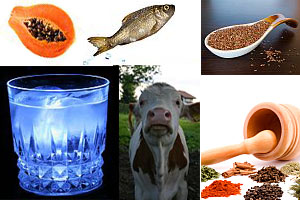[amd-zlrecipe-recipe:12]
Auto Injuries Increase Risk of Future Back Pain
 The National Highway Traffic Safety Administrations reports that more than two million people are injured every year in auto-related accidents involving either a passenger vehicle, large truck, or motorcycle. Furthermore, that number appears to be climbing at an alarming rate, increasing more than five percent between 2014 and 2015 alone.
The National Highway Traffic Safety Administrations reports that more than two million people are injured every year in auto-related accidents involving either a passenger vehicle, large truck, or motorcycle. Furthermore, that number appears to be climbing at an alarming rate, increasing more than five percent between 2014 and 2015 alone.
Certainly, being involved in this type of incident can have long-lasting effects. For instance, one study published in the journal Psychosomatic Medicine found that “a substantial minority” of subjects questioned reported experiencing anxiety when traveling in a motor vehicle post-accident, with 10 percent developing post-traumatic stress disorder (PTSD), a condition that, in some cases, plagued them for years.
Well, another recently published study has found that being in a car crash can also result in long-term physical ramifications as well. Specifically, it discovered that back pain can linger or appear long after the vehicle has been fixed and the debris has been cleaned out of the roadway.
In April of 2017, the European Spine Journal presented a study involving 789 adults, all of whom reported experiencing mild low back pain or no pain at all. Upon entering the study, each person was asked whether or not he or she had been in a motor vehicle accident resulting in low back pain, making note of whether their level of pain increased, decreased, or stayed the same six and 12 months down the road.
Approximately 74.8 percent of the participants responded at the six month mark, with 64.5 percent providing input at 12 months. Of those who did respond, researchers noticed a positive correlation between those who had previously been involved in an auto accident and the incidences of low back pain at a later date. In other words, having a car crash in your past may increase your risk of back pain in the future.
This is partially why being assessed right after a car wreck is so critical. While this is relatively standard when it comes to auto injuries that can be seen or easily felt, damage done to the musculoskeletal system isn’t quite so visible or easy to pinpoint, which also makes it easier to ignore.
Educating patients is the first step to helping them resolve any subsequent back issues. The second step is to regularly ask them whether they’ve been involved in a crash, no matter how small. If they have, addressing that issue first and foremost can keep their quality of life from being compromised months, years, or even decades later.
References
- Mayou R, Tyndel S, Bryant B. Long-term outcome of motor vehicle accident injury. Psychosomatic Medicine 1997;59(6):578-84.
- Nolet PS, Kristman VL, Côté P, Carroll LJ, Cassidy JD. The association between a lifetime history of low back injury in a motor vehicle collision and future low back pain: a population-based cohort study. European Spine Journal 2017;doi:10.1007/s00586-017-5090-y
- Traffic Safety Facts. (August 2016). 2015 Motor Vehicle Crashes: Overview. National Highway Traffic Safety Administration.
Do You Know the Top Foods for Healthy Joints?
Keeping our joints healthy is one of the most important things we can do to remain independent and active as we age. Life can become quite challenging for individuals who are immobilized by joint pain, since it can result in reduced physical and social activity as well as a higher risk of psychological and emotional problems.
When it comes to joint health, exercise is very important, but what you EAT also plays a significant part. Here are some of our favorite joint-friendly foods:
Water — Perhaps the single-most important “food” is water. This liquid is essential for maintaining every system within the body. Water helps in the elimination of toxins, including those poisons that can create joint pain. Water also helps in the delivery of nutrients to the various parts of the body and—like the oil in your car—is essential for joint lubrication. Drink plenty of water every day!
Fish — Cold water fish, such as salmon, mackerel, sardines, white tuna, halibut and trout can deliver healthy doses of omega-3 from the fish oil in each serving. Omega-3 fatty acid is known to reduce inflammation that can cause or increase joint pain. Fish oil can also slow down cartilage degeneration. Cartilage is the rubbery substance between bones that allows for smooth movement. When this wears out, movement becomes extremely painful.
Dairy products — In addition to contributing to bone health, dairy products (and particularly low-fat ones) such as cottage cheese, yogurt and milk can also help eliminate painful gout symptoms.
Flax Seeds — Flax is another source of omega-3 and omega-6 fatty acids for great joint health. Flax seeds and flax seed oil are high in antioxidants, which help to prevent or delay some effects of aging. Flax also contains lots of fiber, which can help you feel fuller for a longer time, reducing the likelihood of snacking. Frequent snacking can lead to obesity—a condition frequently associated with joint pain.
Spices —Curry, ginger and cinnamon also have anti-inflammatory properties that can help your joints. Turmeric has been shown to be particularly effective in reducing the symptoms of osteoarthritis. With these spices in the mix, a joint-friendly diet certainly doesn’t have to taste bad or be bland.
Papaya —The Annals of Rheumatic Diseases published a 2004 study showing a strong correlation between low vitamin C intake and rheumatoid arthritis. Those with the lowest vitamin C consumption were 3 times more likely to develop the disease. Though orange juice has a good dose of vitamin C, papaya has nearly twice as much. Not only that, papaya also includes a good dose of beta carotene for even more anti-oxidant joint support.
Tart cherry juice — The anthocyanins contained in this juice are powerful anti-inflammatories that have been shown to reduce arthritis-related inflammation even better than aspirin. In addition, cherry juice is effective in reducing the painful symptoms of gout.
Hamburger Vegetable Soup
[amd-zlrecipe-recipe:11]
Do You Know all of the Health Benefits of Onions?!!
 10 Health Benefits of Onions
10 Health Benefits of Onions
Onions are considered one of the world’s healthiest foods and given that there are varieties of onions, how you use them could be different each time! Grown all over the world, the first record of using onion for health purposes and healing was in the 17th century. The truth is, onions are therapeutic, which is lucky, seeing as Americans eat over 20 pounds of onion per capita, per year. Want to know what is so good about them? Read on!
1. Improved Immunity
Onions contain powerful antioxidants. Antioxidants are flavonoid compounds, which delay or help repair oxidative damage to different cells and tissues in the body. Eating onion regularly can also protect the body and help regenerate the powerful antioxidant vitamin E, which the body needs as a fat-soluble nutrient. Plus, onion contains allicin. Allicin, a plant derived nutrient, is a killer of various viruses and bacteria, which means it’s a good thing if you eat some raw onion when you feel the onset of a cold or flu, this way the immune effect will be the strongest.
2. Reduce inflammation
When inflammation in the body is working properly, it fights against the disease or protect a wound, gets rid of the virus and then leaves the body, It’s when it goes a bit wrong and doesn’t leave the body, that your immunity is compromised. Naturally anti-inflammatory, onions can help fight inflammation, when the inflammation is the problem. Quercetin, found in onion, has proven to inhibit inflammation-causing leukotrienes and the prostaglandins and histamines that are in rheumatoid arthritis, and osteoarthritis. So it can help inflamed joints and chronic inflammation pain.
3. Regulate blood sugar
There has been extensive research into how onions affect blood sugar. This is good news for the 29 million people in the United States who have diabetes. The tests showed that people, who were diagnosed with type 1, and those with type 2 diabetes, had a lower blood sugar level (glucose reading) after eating onions, and it remained low for up to four hours after eating. This means onion could be very helpful in the management of diabetes. This is because of the sulfur compounds in onions that work to increase insulin production and, therefore, lower glucose levels.
4. Cancer preventer
Onions are the richest natural sources of Quercetin you can find. Quercetin is a powerful antioxidant flavonoid that has been linked to inhibiting certain kinds of cancers. Research and clinical trials have been undertaken to learn more about the effect of the quercetin in onions have on cancer, and it is not considered a drug to combat cancer. Eating onions will simply give you many good benefits that could lead to preventing cancer, because of the dietary source of quercetin it contains.
5. Healthy heart
These antioxidants such as quercetin, work to thin the blood and ward off blood clots. This is particularly the case if you eat raw onion. Raw onion lowers the chanced of bad cholesterol (LDL) which keeps hearts healthy. Not just for lowering your cholesterol, eating onions regularly can also lower blood pressure, and keeps the risk of heart attack and heart diseases or heart risks low. Heart risks including arterial hardening and gallstones. Any foods that support heart health are usually recommended by any heart foundation and are part of a balanced diet.
6. Vitamins and minerals
Onions are considered one of the world’s healthiest foods, not surprising as they contain multiple vitamins and minerals. First up there is a rather decent amount of vitamin C in onions, and we all know vitamin C is good for you. Onions also contain vitamin B6. B6 is great for red blood cell formation, Potassium, which is important for low blood pressure, and general heart health and Folate B vitamin bodies need for metabolism and cell growth. Not only the above but they are also a good source of dietary fiber, calcium, iron, low sodium and have no fat.
7. Free radical killer
Free radicals are molecules that attack healthy cells in the body. These free radicals want to steal all the good stuff from healthy cells, like electrons and rebalance, which cause damage to the good cells, this, in turn, affects the body in regards to aging and deterioration. And if your body is overrun with free radicals, oxidative stress is created. You can combat free radicals by eating foods that are high in antioxidants. Onions do this by eliminating free radicals, they even search them out and kill them, and therefore, reducing the aging process and your risk of developing other related diseases.
8. Onion cough syrup
You can make your cough syrup at home from onions, and it does, in fact, taste better than it sounds, and some may say, better than over the counter cough syrups. Using a red or yellow onion, slice it evenly and place at the bottom of a jar. Pour a layer of honey over it, then repeat layering onion slices, and honey until you are out of the onion. (You can use raw or brown sugar instead of honey if you like but it will be much sweeter) Cover the jar tightly and let it sit overnight. After up to 12 hours the liquid in the jar becomes your cough syrup. Take one spoonful, three times an hour. This concoction will begin to break up and mucus, its natural antibiotic properties begin to take effect and the honey works to soothe the throat.
9. Bee stings
The soothing properties of applying a freshly cut slice of onion directly onto a wasp or bee sting can immediately begin to take effect. The enzymes in onions can help break down the compounds found in the venom of a bee or wasp sting. This is what causes the inflammation and subsequent pain and even swelling. Applying onion can reduce all of these things initially. It also helps in the length of time the sting takes to heal. This ‘home remedy’ was once thought to be an old wives tale. Now it is commonly known to be correct, and more importantly, actually work!
10. The healthiest onions
Western yellow onions and shallots are considered the healthiest because of their phenolic and flavonoid content. In general, consuming these versatile vegetables is only ever a good thing, no matter what kind of onion. These two kinds of onions are both from the allium family, and they can be pretty easily interchanged in recipes. They have a slightly different taste in regards to pronounced sweet flavor (shallot) and bite (yellow onion). That does not make them unusable. If anything, it makes them more desirable to the palate, and to the health system.
Today’s article was written by Charmaine and is shared from the following website: http://health.facty.com/food/nutrition/10-health-benefits-of-onions/?utm_source=bing&utm_medium=c-search&utm_term=health%20benefits%20of%20onions&utm_campaign=f-h-10-health-benefits-of-onions&msclkid=57e38f7f3d051891d8f5d5c259ba940f
Chiropractic Effective for Cervicogenic Headache
 According to the World Health Organization (WHO), headache pain is “extremely common,” with headache disorders—which are characterized as head pain that is repeated in nature—afflicting as many as one in 20 individuals on a daily or almost-daily basis. An additional one in seven people deal with the king of all headaches: migraines.
According to the World Health Organization (WHO), headache pain is “extremely common,” with headache disorders—which are characterized as head pain that is repeated in nature—afflicting as many as one in 20 individuals on a daily or almost-daily basis. An additional one in seven people deal with the king of all headaches: migraines.
Another type of headache which can create an amazing amount of throbbing discomfort is a cervicogenic headache. Defined by the American Migraine Foundation as a “secondary headache” whose cause originates somewhere in the neck area even though it presents itself in the head, some research studies have found that these particular headaches tend to respond rather well to chiropractic treatment sessions.
For instance, BMC Research Notes published the results of a single-blinded randomized control trial conducted in Norway which involved 19 individuals between the ages of 18 and 70 who suffered from cervicogenic headaches. Each subject was assigned to one of three groups for a length of 17 months. The first group received actual chiropractic spinal manipulative therapy utilizing the Gonstead Method. The second group received sham chiropractic manipulations, and the third group served as a control and was simply asked to continue with their current treatment regimen, which did not include any type of manual intervention whatsoever.
Upon conclusion of the study, only 12 of the original 19 participants remained, due to either drop outs or the subject being excluded once randomization occurred. However, of these remaining individuals, those assigned to receive actual spinal manipulation reported a reduction in the number of headaches experienced both during the treatment regimen and at follow-ups conducted six months and one year post-treatment. This was particularly notable when compared to individuals assigned to the control group who reported no change in their cervicogenic headache frequency during or post-study.
While this is a rather small sample size, highlighting the need for more research to be conducted in this area, the study’s findings suggest that, for patients struggling with cervicogenic headaches, chiropractic treatment is definitely better than no treatment at all. This is true both short and long term as positive effects are likely to remain long after the sessions have ceased.
Additionally, although headache pain is among one of the most common pains experienced by adults worldwide, that doesn’t mean that people must simply manage their way through it. By engaging in regular chiropractic care, some headaches can be effectively treated at the source. Cervicogenic headaches are one of them, making this treatment method beneficial for patients seeking a reduction in head pain, and an increase in life satisfaction.
-
Cervicogenic Headache. (October 24, 2016). American Migraine Foundation.
- Chaibi A, Knackstedt H, Tuchin PJ, Russell MB. Chiropractic spinal manipulative therapy for cervicogenic headache: a single-blinded, placebo, randomized controlled trial. BMC Research Notes 2017;10:310.doi:10.1186/s13104-017-2651-4
Today’s article was written by Michael Melton and is shared from the following website: https://www.chironexus.net/2018/03/chiropractic-effective-cervicogenic-headache/
Almond-Honey Power Bar
[amd-zlrecipe-recipe:10]
Opiates Ineffective for Chronic Back or Hip Pain
 A new study just published in the Journal of the American Medical Association finds that opioids are not an effective solution for chronic pain.
A new study just published in the Journal of the American Medical Association finds that opioids are not an effective solution for chronic pain.
In this article, researchers from the University of Minnesota studied 240 patients who had chronic back, hip, or knee arthritis pain. Half of the study subjects received opiates; the other half received non-opiate pain medications. Patient progress was evaluated at 3-months, 6-months, 9-months, and one year.
The study found:
- There was no difference in pain-related function between the two groups.
- At 12 months, the nonopioid patients had less pain than did those who received opiates.
- “The opioid group had significantly more medication-related symptoms over 12 months than the nonopioid group”
The study authors write:
“Among patients with chronic back pain or hip or knee osteoarthritis pain, treatment with opioids compared with nonopioid medications did not result in significantly better pain-related function over 12 months. Nonopioid treatment was associated with significantly better pain intensity, but the clinical importance of this finding is unclear.”
Previous research has found that about 20% of patients with musculoskeletal pain are prescribed narcotic pain medications for their symptoms, and another recent study found that 36% of people who overdosed from opiates had their first opioid prescription for back pain.
Another recent study found that chiropractic patients are less likely to use opiates for their pain than are medical patients.
From this research, it seems clear that it’s risky to prescribe opiates for musculoskeletal pain. Chiropractic care is a proven safe and effective approach for both chronic and acute back pain.
Krebs EE, Gravely A, Nugent S, Jensen AC, DeRonne B, Goldsmith ES, Kroenke K, Bair MJ, Noorbaloochi S. Effect of Opioid vs Nonopioid Medications on Pain-Related Function in Patients With Chronic Back Pain or Hip or Knee Osteoarthritis Pain: The SPACE Randomized Clinical Trial. JAMA. 2018 Mar 6;319(9):872-882. doi: 10.1001/jama.2018.0899.
Sweet and Sour Sauce, No Added Sugar
[amd-zlrecipe-recipe:9]
Surprise: Chiropractors Can Treat These 5 Conditions
Read on if you’re stressed, have a migraine or struggle with flexibility.
Chiropractors are trained as neuromusculoskeletal specialists, and one of the main focuses of chiropractic care is the positive impact it can have on a person’s nervous system.
You might think chiropractors are only able to help with back aches, stiff necks, slipped discs and whiplash injuries. If so, you’re not alone – but you’re missing out.
Chiropractic care – which is based on the understanding that, given the opportunity, the mind and body can heal itself – can treat many issues that might surprise you.
Here’s a look at the top five most surprising conditions a chiropractor can treat:
1. Migraines and tension headaches
Nine out of 10 Americans suffer from headaches. Some are occasional. Some are persistent. Some are dull and nagging, while others cause debilitating pain and nausea. Taking a painkiller and hoping your headache goes away is one option. But there’s a better one.
Research shows that spinal manipulation – the primary form of care provided by chiropractic doctors – is an effective way to treat tension headaches and headaches that begin in the neck.
In a clinical trial conducted at Macquarie University, 72 percent of migraine sufferers experienced either “substantial” or “noticeable” improvement after a period of chiropractic treatment.
In fact, most headaches are related to muscle tension in the neck, which is an increasingly common condition among Americans who spend hours in the same position or posture (such as in front of a computer or television), leading to joint irritation and tension in the upper back and scalp that cause headaches.
What Can a Doctor of Chiropractic Do?
- Perform spinal manipulation or chiropractic adjustments to improve spinal function and alleviate stress on your system.
- Provide nutritional advice, recommending a change in diet or the addition of vitamins.
- Offer advice on posture, ergonomics, exercises and relaxation techniques.
2. Stress and anxiety
We perceive stress from three basic sources: our environment, our body and our emotions.
Environmental stress includes noise, weather, physical threats, time pressures and performance standards. Body stress includes disease processes, organ malfunction, poor nutrition, poor sleep and physical injury. And emotional stress is more difficult to define, but it encompasses our reactions, in both thought and emotion, to environmental and physical stressors.
Jobs today are increasingly complex as the business world becomes more and more competitive. Physical stresses such as sound, air and water pollution have also grown worse over the last century – especially in the United States – and so have emotional and psychological stresses caused by an increasing awareness of troubles and tragedies around the globe, brought to our attention every hour by the Internet and its 24/7 news cycle.
Many illnesses are caused or worsened by stress, which activates our “fight or flight” reaction. This systemic reaction affects almost every part of the body, as the hypothalamus in the brain stimulates the sympathetic nervous system, which causes an increase in heart rate, blood volume and blood pressure, redirecting blood away from our digestive system and extremities.
When prolonged, the long-term effects of this state can be disastrous to good health and cause high blood pressure, muscle tissue damage, diabetes, infertility, damage to the immune system and slowed healing from disease and injury.
Chiropractors work primarily with the spine – the root of the nervous system through which nerve impulses travel between the brain and the rest of the body – and can help the body manage and process this stress in a healthier way.
What Can a Doctor of Chiropractic Do?
- Chiropractors can release muscle tension, one effect of chronic stress that leads to nerve irritation and creates uneven pressures on the body’s bony structures, which can cause the spinal column to become misaligned. This, in turn, helps the body return to a more balanced, relaxed state.
- Chiropractic adjustments can reduce spinal nerve irritation and improve blood circulation, which can help signal the brain to turn off the “fight or flight” response and begin the healing process.
- A doctor of chiropractic can suggest nutritional supplements, like B complex vitamins, to help the body cope with stress.
- A chiropractor can also recommend relaxation techniques and discuss posture and environmental changes to help you recover from chronic stress.
3. Fibromyalgia
Fibromyalgia is a chronic disorder involving widespread pain and sensitivity throughout the entire musculoskeletal system. To be diagnosed with FM, a patient typically has a minimum of 11 out of 18 specific tender points on the body. In addition to pain, patients also report long-term fatigue and/or disturbed sleep and mood. Other disorders commonly associated with FM include irritable bowel syndrome, TMJ pain and dysfunction, psychological conditions and some autoimmune diseases.
Fibromyalgia is a widespread condition that affects about 2 percent of the United States, and medical science has yet to discover the cause of this condition.
Since those with FM often experience an altered mood, like depression, many experts focus on the psychological aspect of the disease. Others feel that FM is more physiological and has its origins in physical trauma or chronic postural alterations. Still others suggest that FM is a central nervous system disorder rooted in neurochemical imbalances, since those with FM are hypersensitive to even the slightest stimuli and often have a pain response to normally non-painful pressure or activity. Since all information from the outside world is collected and analyzed by the nervous system, it’s logical to assume that if a person with FM is sensitive to a stimulus that others are not, there may be something wrong with this system.
It’s often difficult for patients to find solutions for all of their symptoms, but recent studies show that chiropractic adjustments combined with a soft tissue technique called ischemic compression can help FM patients.
In one study, 60 percent of the subjects treated by a chiropractor experienced a significant improvement: reduced pain, improved sleep and decreased fatigue.
What Can a Doctor of Chiropractic Do?
- Chiropractors are trained as neuromusculoskeletal specialists, and one of the main focuses of chiropractic care is the positive impact it can have on a person’s nervous system. Therefore, chiropractic adjustments can improve a FM patient’s nervous system, which gives them a better chance for recovery.
- Chiropractic care can treat pressure points, back pain, neck pain, shoulder pain, headaches and pain from musculoskeletal injuries.
- Chiropractors can also reduce a patient’s overall pain through spinal adjustments that increase the mobility between spinal vertebrae, which have become restricted, locked or slightly out of proper position, thereby increasing cervical and lumbar range of motion.
4. Weak immune systems
The nervous system, endocrine system and immune system are inextricably linked. Together they share tiny messenger molecules that mediate communication between them, creating optimal responses for the body to adapt and heal appropriately.
Until recently, one of these messenger molecules, IL-2, was thought of as an immune system molecule. But recent studies have clearly shown its presence and activity in the nervous system, leading researchers to believe that neural dysfunctions due to spinal misalignments are stressful to the body and can cause abnormal changes that lead to a poorly coordinated immune response.
Subluxation is the term for misalignments of the spine that cause compression and irritation of nerve pathways, affecting the body’s organs. Subluxations are an example of physical nerve stress that affects neuronal control. According to researchers, such stressful conditions lead to altered measures of immune function and an increased susceptibility to a variety of diseases.
It’s important to note here how the endocrine system also impacts the immune system by producing cortisol in the adrenal glands – endocrine glands that are directly connected to the nervous system through the sympathetic nervous system – a stress hormone that inhibits the immune system.
If the sympathetic nervous system is too “switched on” due to stress and subluxation, it can increase the adrenal glands’ synthesis of cortisol, in turn affecting the immune system.
What Can a Doctor of Chiropractic Do?
- Chiropractic care is the only way to detect and eliminate subluxation, and chiropractic adjustments have been shown to reduce the stress on the nervous system, thereby boosting the coordinated responses of the nervous and immune systems.
- One research group found that when an adjustment was applied to a subluxated area, the white blood cell count collected rose significantly.
- Another study measured the effects of six months of regular chiropractic care on the immune system function of HIV patients. At the end of six months of care, the patients who had received regular adjustments showed a 48 percent increase in the number of CD4+ T cells, whereas patients who had not been adjusted showed an 8 percent decrease in CD4+ T cells.
5. Flexibility
When we’re younger, it’s easy to take our extensive range of motion and flexibility for granted. As we age, a number of health conditions – and the cumulative effects of wear and tear – can affect our ability to move the way we used to.
But a decrease in range of motion and flexibility can result in a downward spiral of disability.
For example, an injury or degenerative condition that causes pain, swelling and stiffness, may limit our flexibility and range of motion. When this happens, we may avoid activities that involve the affected body parts, either consciously or unconsciously.
This then becomes a classic case of “use it or lose it.” Without regular exercise, the muscles and joints stiffen, adhesions and scar tissue can form, and mobility may be further reduced. Eventually, a person can become completely incapacitated, and ordinary tasks such as picking up something off the floor or tying your shoes can become extremely challenging or painful.
Regular chiropractic can help increase both range of motion and flexibility.
A study performed by researchers at the Phillip Chiropractic Research Centre of RMIT University in Melbourne, Australia, and published in the Journal of Manipulative and Physiological Therapeutics found that chiropractic adjustments increased range of motion in the 105 patients who participated in the study. There were three phases of this study, in which each of the participants was given no adjustments, fake adjustments or true adjustments. In each phase, the patients who were given the true adjustments showed a significant improvement in range of motion, which was not the case for the other two groups.
What Can a Doctor of Chiropractic Do?
- A chiropractor uses spinal adjustments and manipulations to other parts of the body to realign the bones and joints so as to reduce pain, restore range of motion and improve flexibility, balance and coordination.
- Your chiropractor can also recommend specific exercises that can be done at home to increase your strength and flexibility so that you’re able to maintain and build upon the gains from your chiropractic adjustments.
- Regular chiropractic care can reduce or eliminate the source of your back and joint pain, allowing you to resume your normal activities and to remain more flexible into your golden years.
Today’s article was written by Dr. David L. Starr is the founder of Starr Physical Therapy, Chiropractic and Acupuncture in New York City, where he has successfully practiced chiropractic for the past 18 years. A native New Yorker, Starr graduated from Life College in Atlanta, Georgia and donated his skills to Flying Doctors of American in the Dominican Republic before returning to New York City and establishing a successful, multidisciplinary office in Union Square.
Today’s article is shared from the following website: https://health.usnews.com/health-news/patient-advice/articles/2015/11/30/surprise-chiropractors-can-treat-these-5-conditions





